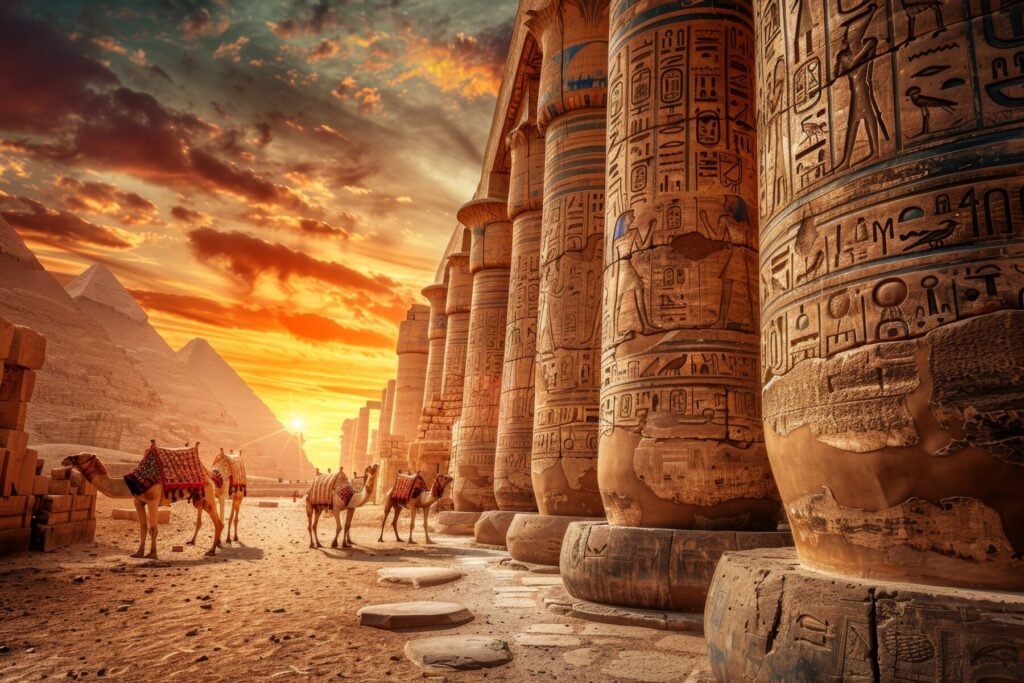Sudan is home to over 200 ancient pyramids, surpassing the number of pyramids in Egypt. These structures, known as the Nubian pyramids, were built by the Kingdom of Kush between 3000 BC and 350 AD as royal tombs for their kings and queens. Located in northeastern Sudan, the pyramids are a testament to the rich history and culture of the Kushite civilization .

Unique Architectural Style:
The Nubian pyramids differ significantly from their Egyptian counterparts. They feature steeper angles, smaller bases, and are constructed from sandstone and granite. The pyramids’ design showcases the Kushite’s understanding of astronomy, with many structures aligned with celestial bodies. The Pyramid of Queen Amanitore in Meroë is a notable example, with its elaborate decorations and inscriptions 1.
Historical Significance:
The Kingdom of Kush, which built these pyramids, was a powerful and influential civilization that thrived in Nubia, south of Egypt,
starting in the 8th century BCE. The Kushites were known for their iron production, trade networks, and military prowess, and even conquered Egypt, ruling as pharaohs of the XXV dynasty. The pyramids symbolize the wealth and power of the Kushite rulers and reflect their belief in an afterlife and divine connections.
Major Pyramid Sites: – Meroë:
Meroë is a significant archaeological site in Sudan, boasting an impressive collection of over 40 pyramids. As the capital of the Kushite kingdom, Meroë showcases the rich history and culture of this ancient civilization. The site’s tomb designs offer valuable insights into the funerary practices of the Kushites, revealing their beliefs and traditions surrounding death and the afterlife. The pyramids at Meroë are a testament to the advanced engineering and architectural skills of the Kushites, who constructed these structures using local sandstone and granite. Today, Meroë remains an essential destination for historians, archaeologists, and anyone interested in exploring the wonders of ancient Nubia.
– Napata:
Napata is a notable archaeological site that served as a crucial center of the Kushite kingdom. Located near the Fourth Cataract of the Nile River, Napata was an important spiritual and political hub, housing several pyramids and temples. The site’s pyramids reflect the Kushite’s reverence for their rulers and deities, while its temples demonstrate their advanced architectural skills. Napata’s strategic location facilitated trade and cultural exchange, contributing to the kingdom’s prosperity. Today, Napata remains a significant historical site, offering insights into the Kushite civilization’s achievements and legacy.
– El-Kurru:
El-Kurru is a significant archaeological site that serves as the final resting place for several prominent Kushite rulers, including King Kashta and his son Piye. This ancient necropolis provides valuable insights into the funerary practices and traditions of the Kushite kingdom. The tombs at El-Kurru showcase the architectural skills and craftsmanship of the Kushites, who constructed these structures to honor their monarchs. The site is also important for understanding the history and legacy of the Kushite dynasty, which played a significant role in shaping the culture and politics of ancient Nubia.

Preservation and Tourism:
The preservation and promotion of the Nubian pyramids are crucial for their longevity and accessibility. Despite their historical significance, these ancient structures are often overlooked, but efforts are underway to raise awareness and protect them. Tourism can be a valuable tool in supporting conservation initiatives, generating revenue, and promoting cultural exchange. However, it’s essential for visitors to respect site regulations, follow guidelines, and support local guides to ensure the pyramids’ protection and preservation for future generations. By working together, we can safeguard these incredible monuments and share their rich history and cultural significance with the world.
Conclusion:
In conclusion, the Nubian pyramids of Sudan stand as a remarkable testament to the country’s rich history and cultural heritage. These ancient structures, with their unique architectural style and historical significance, offer a fascinating glimpse into the lives and traditions of the Kushite civilization. As a treasure trove of knowledge, the pyramids are a must-visit destination for anyone interested in exploring the wonders of ancient civilizations. By preserving and promoting these incredible monuments, we can gain a deeper understanding of the past and appreciate the cultural achievements of the Nubian people.
